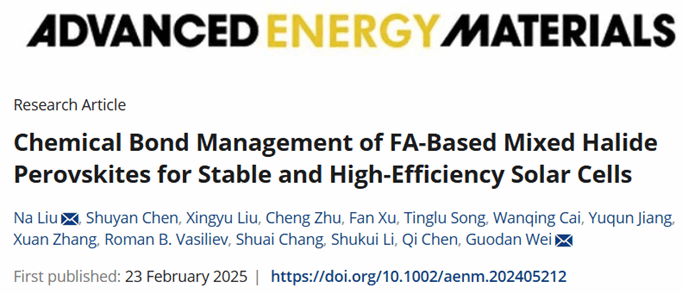Recently, Associate Processor Liu Na from the applied nanophotonics team of SMBU Faculty of Materials Science has made great research progress in perovskite solar cells, with the related research achievements published in the top journals in the material field- Advanced Energy Materials and Energy Material Advances.

The research paper titled “Chemical Bond Management of FA‐Based Mixed Halide Perovskites for Stable and High‐Efficiency Solar Cells” was published in Advanced Energy Materials (Impact Factor: 24.4, CAS Q1) with Shenzhen MSU-BIT University as the first corresponding institution, Associate Processor Liu Na as the first author & corresponding author, and Associate Processor Wei Guodan from Tsinghua University as the co-corresponding author. This research was supported by Professor Li Shukui from SMBT Faculty of Materials Science, Processor Chang Shuai, head of the applied nanophotonics team, Processor Roman Vasiliev from Moscow State University and Processor Chen Qi from Beijing Institute of Technology.
The research on stability of perovskite solar cells has made an significant breakthrough. The adoption of a pyrrolidine compound (PY-F) with strong electron-withdrawing fluorine substituents significantly enhanced the chemical bond strength between organic cations and [PbI6]4− octahedron, effectively suppressing iron migration and phase transition. Meanwhile, the reaction between PY-F and PbI2 formed a novel 1D perovskite structure (PYFPbI3) which constructs a heterojunction with the 3D perovskite, further enhancing the material stability. The optimized rigid perovskite solar cells achieved a 25.39% power conversion efficiency, and the efficiency of flexible device reached 24.26%, representing the advanced level in similar researches. Especially, after the 350h maximum power point tracking under continuous illumination, the unpacked devices could retain 90% of their original efficiency, much higher than the control group (degraded to 45%). Furthermore, after 1000 bending cycles, the flexible devices still maintained 97% of their performance, demonstrating their outstanding mechanical stability. Through the innovative chemical management strategy, this research successfully enhanced the efficiency and long-term stability of formamidinium-based mixed halide perovskite solar cells, providing new thoughts for commercial application of perovskite solar cells.

In addition, through the cooperation with Processor Chen Qi from Beijing Institute of Technology, the applied nanophotonics team published a research paper titled “Amidinium-Enhanced Charge Dissociation in Homogeneous Quasi-2-Dimensional Perovskite Solar Cells” (Impact Factor: 14.9, CAS Q1), with Shenzhen MSU-BIT University as the first corresponding institution, Associate Processor Liu Na as the first author & corresponding author, Processor Chang Shuai and Processor Chen Qi as co-corresponding authors.
For the difficulties in quasi-2-dimensional perovskite solar sells such as uneven phase distribution and low exciton fission efficiency, this research developed a novel butyramidinium chloride compound (BI) with both Lewis base properties and chloride functionality, successfully addressing the above challenges and providing new thoughts for stable and high-efficiency perovskite PV technology. The research team introduced BI molecules to leverage the strong Lewis base interaction between the amidine base (NH=CNH₂) and [PbI6]4− octahedron, thus optimizing the crystallization kinetics and promoting the formation of highly oriented crystal structures in in the films. In addition, chloride ions effectively suppressed the formation of low n-value phases, producing even n=4 dominant phase distribution in the films. The synchrotron-radiation grazing-incidence wide-angle X-ray scattering (GIWAXS) and the photoluminescence spectroscopy verified that the BI-treated film’s crystallinity was significantly enhanced with the exciton binding energy reduced from 231 meV to 180 meV, effectively improving the charge separation. The experimental results revealed the outstanding performance of the optimized quasi-2-dimensional perovskite solar sells. This research has established a new molecular design paradigm for efficiency enhancement of quasi-2-dimensional perovskite solar sells, and also provided a solution for charge transmission and phase stability in low-dimensional perovskites.
Professor Chang Shuai, head of the applied nanophotonics team of Shenzhen MSU-BIT University, and the team members including Associate Processor Liu Na, Senior Lecturer Zhu Yanan, 2 postdoctoral researchers and several Doctoral and Master candidates conducted the relevant researches on SMBU’s “applied nanophotonics platform”. Facing Shenzhen “20+8” industry clusters including novel optoelecronic materials, new display technologies and new energies, they conducted the researches on new optoelecronic technologies represented by nano-optoelecronic materials, printed display devices and PV energy devices. They were committed to exploring new optoelecronic materials and developing new optoelecronic device fabrication technologies. They strove to make original breakthroughs to achieve the localization and domestication of core technologies, build an integrated research system from material breakthrough to system integration, make contributions to “corner overtaking” of optoelecronic materials and technologies, and promote the transformation and upgrade of related industrial chains.